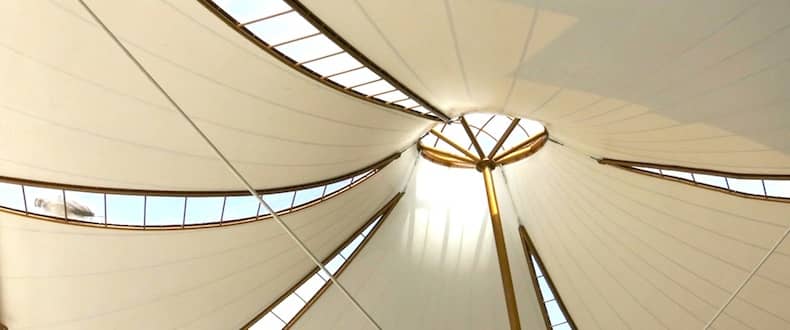 Before using architectural fabrics in your new construction project or next building renovation, it’s important to consider the longevity of the material and the warranty offered.
Before using architectural fabrics in your new construction project or next building renovation, it’s important to consider the longevity of the material and the warranty offered.
As a building owner, for example, you need to be sure the fabric you choose will maintain its structural integrity and remain aesthetically pleasing for decades to come. When reading the warranty, you should ask yourself questions like: Will it retain its integrity? What will the fabric look like in 10, 20 or even 30 years after the project is completed? Will the material retain its brightness and color? Alternately, you should ask yourself whether the fabric will become dull, spotted or faded and become a virtual blight. And, most importantly, after each question you should ask this follow-up: Does the warranty explicitly cover this?
When new and properly installed, any architectural fabric will look great. However, time and environmental conditions have a way of dramatically changing the appearance of some of these materials unless they are properly designed to protect against specific conditions.
What to Consider First: Do Aesthetics Matter?
Architectural fabric manufacturers and installers offer warranties that usually guarantee a fabric’s durability for 20 years. However, most warranties do not cover the appearance of the fabric. So, while improperly designed architectural fabrics may become discolored, faded, dirty and unsightly within those 20 years, they often won’t have a warranty that guarantees otherwise.
Of course, aesthetics may not matter for your application. A structure or building that is used for industrial or agricultural purposes (for functional purposes like storage and warehousing), or a piece of private property largely outside the public’s eye, may not require an architectural fabric that maintains its aesthetics. However, if the structure or building is a church, casino, recreation center or any other structure widely used by the public, then both structural integrity and long-term aesthetics should be taken into consideration before signing off on a warranty.
What to Consider Next: Do Certain Manufacturers Offer Better Warranties?
The answer to this question is found in the details. While it’s true that warranties vary by manufacturer, they also vary by specific architectural fabric characteristics such as strength, UV resistance, cleanability, etc.
Some manufacturers offer more comprehensive warranties. For example, Seaman Corporation’s Shelter-Rite® Architectural Fabrics are all backed by one of two comprehensive warranties—depending on the type of top coat material an architectural fabric has. One warranty is for all fabrics coated with Tedlar® PVF film and the other is for those using solution-applied top finishes (i.e., acrylic or PVDF).
- Acrylic material or PVDF warranty: Guarantees structural integrity and durability for 20 years, and warrants these fabrics to retain not less than 70% of the published tensile strength (ASTM D-751, Cut Strip Method) for the life of the warranty.
- Tedlar® PVF film warranty: Guarantees structural integrity, durability and aesthetic properties for 20 years. Whether air-supported, a tensile structure or custom structure, these fabrics should not radically change appearance during that time. This is because Seaman Corporation warrants the UV resistance, film adhesion and cleanability of the Tedlar® film, and also warrants these fabrics to retain not less than 70% of the published tensile strength (ASTM D-751, Cut Strip Method) for the life of the warranty.
The Essential Takeaway: Read the Warranty Closely
This can’t be overstated enough. Warranties from some architectural fabric manufacturers will assure durability but not aesthetics. Over time, these architectural fabrics will begin to accumulate dirt, discolor and show color variation. When these structures are used in highly visible public locations, this aesthetic degradation can become an eyesore in the community.
And how can you avoid this? You guessed it—by reading the warranty closely.
What factors do you consider before agreeing to a warranty? Tell us about them in the comments!


